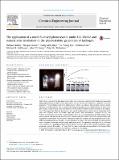The application of a novel fluidised photo reactor under UV-Visible and natural solar irradiation in the photocatalytic generation of hydrogen
Date
15/02/2016Author
Grant ID
WRMA 2012/R2
EP/K015540/1
EP/H004130/1
Keywords
Metadata
Show full item recordAbstract
With advancements in the development of visible light responsive catalysts for H2 production frequently being reported, photocatalytic water splitting has become an attractive method as a potential ‘solar fuel generator’. The development of novel photo reactors which can enhance the potential of such catalyst, however, is rarely reported. This is particularly important as many reactor configurations are mass transport limited, which in turn limits the efficiency of more effective photocatalysts in larger scale applications. This paper describes the performance of a novel fluidised photo reactor for the production of H2 over two catalysts under UV–Visible light and natural solar illumination. Catalysts Pt-C3N4 and NaTaO3·La were dispersed in the reactor and the rate of H2 was determined by GC-TCD analysis of the gas headspace. The unit was an annular reactor constructed from stainless steel 316 and quartz glass with a propeller located in the base to control fluidisation of powder catalysts. Reactor properties such as propeller rotational speed were found to enhance the photo activity of the system through the elimination of mass transport limitations and increasing light penetration. The optimum conditions for H2 evolution were found to be a propeller rotational speed of 1035 rpm and 144 W of UV–Visible irradiation, which produced a rate of 89 μmol h−1 g−1 over Pt-C3N4. Solar irradiation was provided by the George Ellery Hale Solar Telescope, located at the California Institute of Technology.
Citation
Skillen , N , Adams , M , McCullagh , C , Ryu , S Y , Fina , F , Hoffman , M R , Irvine , J T S & Robertson , P K J 2016 , ' The application of a novel fluidised photo reactor under UV-Visible and natural solar irradiation in the photocatalytic generation of hydrogen ' , Chemical Engineering Journal , vol. 286 , pp. 610-621 . https://doi.org/10.1016/j.cej.2015.10.101
Publication
Chemical Engineering Journal
Status
Peer reviewed
Type
Journal article
Collections
Items in the St Andrews Research Repository are protected by copyright, with all rights reserved, unless otherwise indicated.

